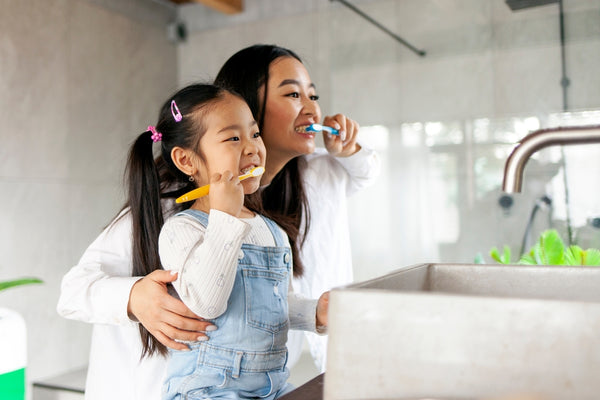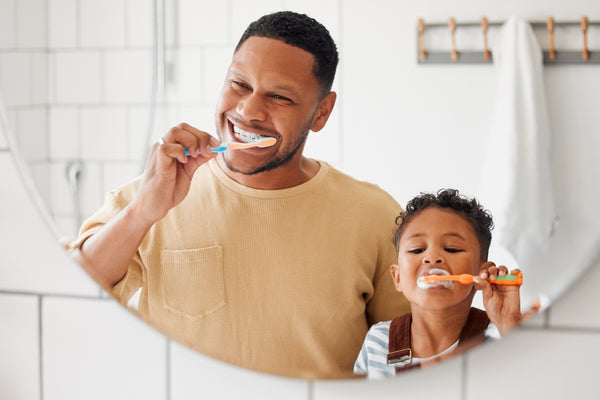
Little Smiles: A Comprehensive Guide to Children's Teeth Brushing
EDDOral care is crucial to overall health and well-being, making it essential to establish good oral hygiene practices from an early age. Teaching children the importance of proper dental habits not only promotes a lifetime of healthy teeth and gums but also supports their ability to eat, speak, and focus in school.
By preventing tooth decay and other dental issues early on, you can help avoid potential complications such as infections and adverse effects on the development of permanent teeth. Prioritizing oral care lays the foundation for your child's lifelong health and confidence.
Not sure how to take care of your child's teeth? Don't worry. This blog will provide step-by-step instructions and practical tips to make teeth brushing a breeze.
Should I Brush My Baby's Gums?
It is a good idea to clean your baby's gums even before their first tooth emerges. Cleaning your baby's gums helps remove bacteria and debris, establishing good oral hygiene habits from the start. Here's how to clean your baby's gums:
- After feedings, wrap a clean, damp washcloth or gauze around your finger.
- Gently wipe your baby's gums with the damp cloth or gauze, using a circular motion.
- Be gentle and thorough, ensuring you clean the entire gum line, including the areas where teeth will eventually emerge.
- You can do this after each feeding to keep your baby's mouth clean and free from bacteria.
Cleaning your baby's gums not only helps maintain oral hygiene but also gets your baby accustomed to the sensation of having their mouth cleaned, which can make the transition to toothbrushing easier when their first tooth emerges.

When Do You Start Brushing Baby Teeth?
The American Dental Association (ADA) recommends starting to brush your baby's teeth as soon as the first tooth appears, which typically occurs around six months of age. Plaque can start to form on the surfaces of the tooth and cause decay. But this is likely not going to be easy—you have to make it a part of your daily routine.
How to Brush Your Baby's Teeth
Here are some tips to brush your toddler's teeth:
- Prepare: Choose a soft-bristled baby toothbrush and fluoride toothpaste specifically formulated for children. Place a rice-grain-sized smear of toothpaste on the brush.
- Positioning: Sit your baby in a comfortable position, either on your lap or on a changing table. Ensure good lighting so you can see clearly inside your baby's mouth.
- Technique: Hold the toothbrush at a 45-degree angle to the gums, using your thumb and middle fingers. Gently brush the front and back of each tooth using circular motions. Pay extra attention to the gum line and side of each tooth, where plaque tends to accumulate. Be gentle to avoid irritating the gums.
- Flossing: If your baby has multiple teeth, consider incorporating flossing into their oral hygiene routine. Use a soft-bristled baby toothbrush or flosser to gently move the floss between their teeth. Be careful not to force the floss, as this can harm their gums.
- Duration: Brush your baby's teeth for about two minutes, ensuring you clean all tooth surfaces thoroughly.
- Consistency: Make brushing and flossing a part of your baby's daily health care routine. Brush their teeth twice a day—once in the morning and once before bedtime—to maintain good oral hygiene.
How to Choose the Right Toothbrush for Your Child
When it comes to choosing the right toothbrush for your child, remember that one size does not fit all. You've got to consider your child's age, unique needs, and abilities. But ideally, you should look for a kid-friendly toothbrush. The toothbrush should have a small head and a compact, rounded shape that fits comfortably in your child's mouth. This allows for easy maneuverability and access to all areas of their teeth and gums.

The toothbrush should have soft bristles, as they are gentle on your child's teeth and gums. Soft-bristled brush effectively removes plaque and debris without causing irritation or damage to their delicate oral tissues. It should also have age-appropriate features and designs that appeal to your child. Many toothbrushes come in fun colors, patterns, and characters, making brushing more enjoyable for children.
Let your child pick out their toothbrush to encourage enthusiasm for oral hygiene. It's an added benefit if the toothbrush has a wide, easy-to-grip handle that fits comfortably in your child's hand. A textured or rubberized handle can provide better grip and control, especially for younger children who are still developing their fine motor skills.
Remember to replace your child's toothbrush every 3-4 months or sooner if the bristles become worn or frayed. Using a worn-out toothbrush can be less effective at cleaning their teeth and may harbor bacteria.
How to Choose the Right Toothpaste
Look for toothpaste specifically formulated for your child's age group. For children less than three years old, choose fluoride toothpaste with a rice-grain-sized smear. For children three years and older, use a pea-sized amount of fluoride toothpaste.
Fluoride strengthens tooth enamel and helps prevent tooth decay. If your child has sensitive teeth or gums, use toothpaste specifically designed for sensitive teeth. This toothpaste contains ingredients that help desensitize the teeth and provide relief from sensitivity.
Pediatric Dental Care
The ADA and other reputable children dental health organizations recommend that children have their first dental visit within six months of their first tooth eruption. That's usually around their first birthday. Early dental visits allow pediatric dentists to assess your child's oral health, monitor dental development, and provide guidance on oral hygiene practices.
How to Make Brushing Teeth Fun for Kids

Making brushing teeth fun for kids can help encourage good oral hygiene habits and make the experience more enjoyable. Here are some tips to make brushing your teeth a fun and positive activity for children:
- Let your child pick out a toothbrush with a fun design, bright colors, or their favorite cartoon character. A toothbrush featuring their favorite character can make brushing more exciting.
- Play their favorite song or create a brushing teeth playlist. Encourage them to brush along to the music, using the duration of the song as a timer for brushing.
- Establish a consistent brushing routine that includes specific times for brushing to reinforce good habits and makes brushing feel like a regular part of their daily routine.
- Set a timer or use a toothbrushing app with a built-in timer to make brushing more engaging. Challenge your child to brush for the entire duration of the timer or until a fun sound goes off.
- Turn brushing teeth into a game or competition. Track their progress with a sticker chart and reward them with stickers or small prizes for brushing consistently and thoroughly.
- Brush your teeth alongside your child to serve as a positive role model and make brushing a shared activity. Make silly faces or mirror their movements to make brushing more entertaining.
- Create a story or scenario while brushing your teeth. Encourage your child to pretend they are brushing away "sugar bugs" or "cavity monsters" to save their teeth from decay.
- Let your child pick a toothpaste flavor they enjoy, such as strawberry, watermelon, or bubble gum. The appealing taste can make brushing more enjoyable for them.
- Celebrate milestones and achievements in oral hygiene, such as a cavity-free dental check-up or reaching a certain number of consecutive days of brushing. Offer praise and rewards to motivate your child to continue brushing regularly.
- Offer plenty of praise and encouragement during and after brushing. Positive reinforcement helps reinforce good behavior and makes brushing a positive experience for your child.
With these tips, you should be well-equipped to maintain good oral hygiene and keep your teeth and gums healthy. If you are looking for dental care products or tools for a dental practice, Dental Finds has got you covered.

